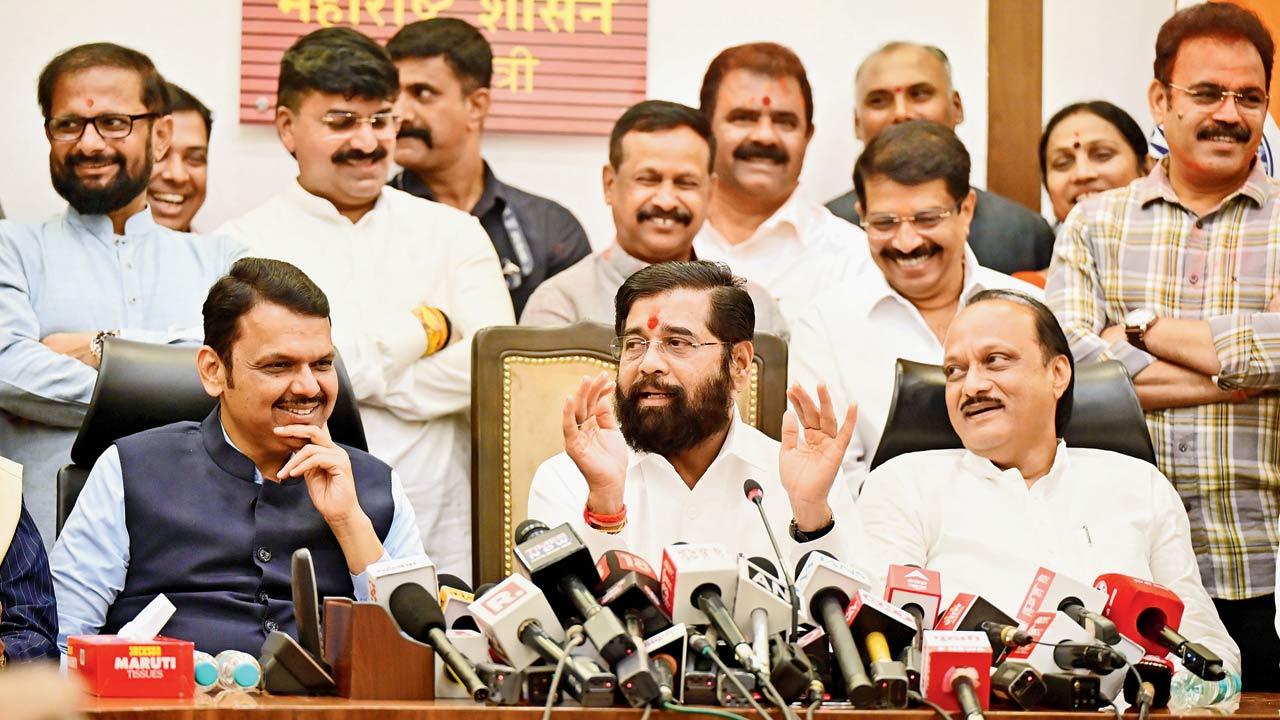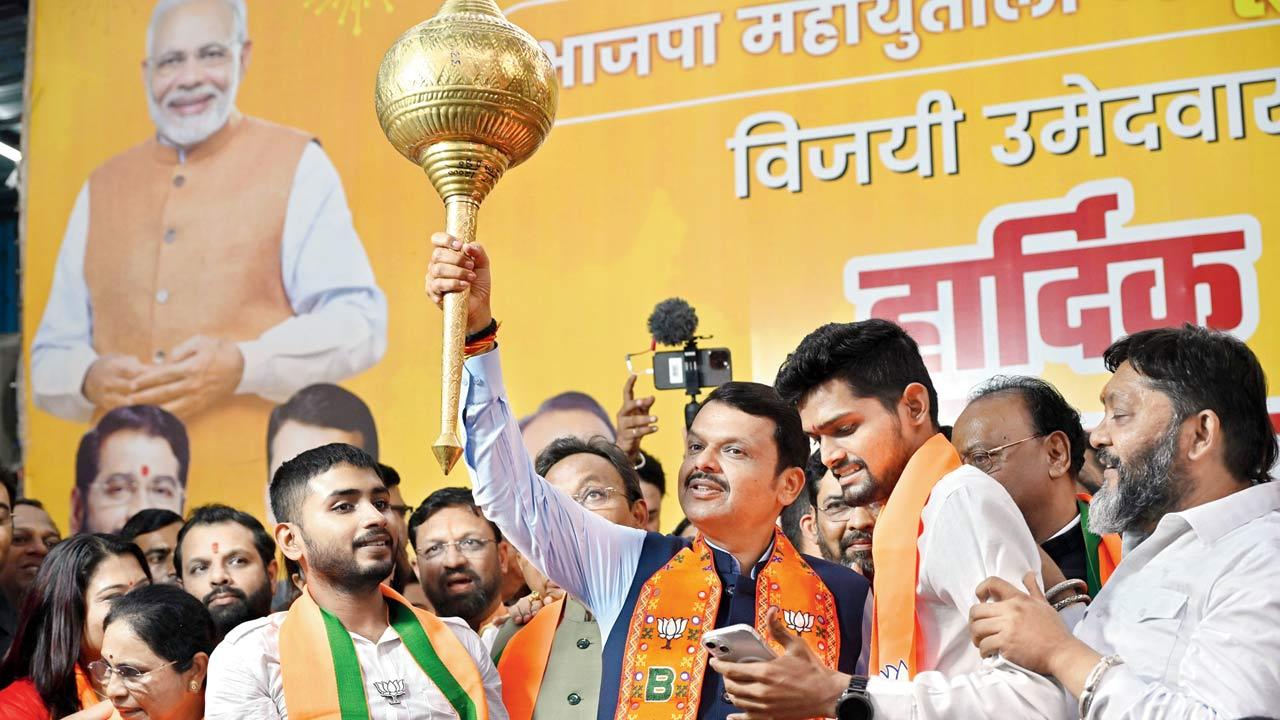Race for top job heats up, with Sena asking for another two-and-a-half years as CM for Eknath Shinde, while BJP state leaders want Fadnavis to take charge

(Right) Eknath Shinde and Devendra Fadnavis interact after winning the Maharashtra Assembly elections on Saturday. Pic/Shadab Khan
 The massive mandate for the Bharatiya Janata Party (BJP) in the Maharashtra elections has drawn a thick line between it and its allies, one of which is an ideological partner and the other not in full agreement with the ideology the BJP advocates. It is the line that separates a bulkier BJP from the rest and allows it to test new things if need be. It wields command over the allies despite their increased strength and stature.
The massive mandate for the Bharatiya Janata Party (BJP) in the Maharashtra elections has drawn a thick line between it and its allies, one of which is an ideological partner and the other not in full agreement with the ideology the BJP advocates. It is the line that separates a bulkier BJP from the rest and allows it to test new things if need be. It wields command over the allies despite their increased strength and stature.
ADVERTISEMENT
THE BJP has 136 MLAs including four from small allies, Shinde Sena has 57, and NCP (AP) 41 legislators. The MVA has ended up with 49, which includes Congress's 15, Thackeray Sena's 20, NCP (SP)'s 10, and four from small allies.
The very sense of things changing overnight is enough to create unrest among the partners, especially the Shinde Sena. The NCP has nothing to lose; it stands to gain, perhaps more than expected. The question here is whether the BJP will have as much in its share, and also take the CM's office away from Eknath Shinde. How will the alliance dharma play out for Shinde and Ajit Pawar?
 Devendra Fadnavis, CM Eknath Shinde, and Ajit Pawar address the press after winning the state Assembly elections. Pic/Shadab Khan
Devendra Fadnavis, CM Eknath Shinde, and Ajit Pawar address the press after winning the state Assembly elections. Pic/Shadab Khan
Cut to the past. There was a time when the Congress had 200-plus seats in the state Assembly. The Congress then started fighting battles within, instead of taming the rising Opposition (the BJP, the Sena, and later NCP). The days of Congress dominance were gone when alliance politics emerged as a permanent feature since 1995. It was shaped further to give subsequent four governments of the parties sharing an ideology.
There was an aberration much before this happened. Sharad Pawar, in his first tenure as the CM (July 1978 to February 1980) had formed a coalition of ideologically different parties -- his Congress (Socialist) breakaway, the leftist parties, and the Janata Party was a mix of right-wingers and socialists. Later, as a non-playing captain in 2019, Pawar formed such a government once again, with his NCP, Congress, and Shiv Sena forming the MVA. A few days before MVA was founded, his nephew Ajit Pawar had made a short-lived government with an ideologically opposite BJP. Pawar has been denying his hand in the NCP-BJP formation and the return of Ajit Pawar, though his nephew and others in the know have said time and again that it was Pawar senior who had agreed to such a formation, not only in 2019 but also in 2017. All these formations were short-lived.
The long introduction to this piece is to differentiate between the previous “ideologically mixed” dispensations, and the one that came into existence in 2023. It is the first such pre-poll alliance that has been granted grand approval by voters. The endorsement could be attributed in great measure to the BJP's record individual gain, and its 'gelling well' with allies. Yet, the BJP's commanders may face some resistance. There is likelihood of the allies bargaining for more share in power, and rightly so -- the CM's office (Shinde Sena) and plum ministries (both allies), included. Crowded as never before, the BJP's state house is already tense, fearing largesse at the hands of their high command. So, it is to be seen if the Sena and NCP are allowed to eat into what the BJPwallahs call their legitimate share, particularly the CMO. They don't want a repeat of June 2022, where Devendra Fadnavis was demoted to reward Eknath Shinde for his adventure of dividing the Shiv Sena that had enabled BJP to retain power after two-and-a-half years. But in doing so, the BJP has remained without the CM's office because of the MVA experiment and later for the purpose of honouring Shinde.
 Devendra Fadnavis celebrates victory outside the BJP office at Nariman Point. Pic/Atul Kamble
Devendra Fadnavis celebrates victory outside the BJP office at Nariman Point. Pic/Atul Kamble
Sensing the BJP's eye on the top job, the Shinde camp has invoked their 'daring do' the rebellion of 2022 that split the undivided Sena to justify their demand for the CMO for their party boss, at least for the first two and half years, if not for full term. They say it was because of their revolt that the BJP could return to power, without which the national party's exponential growth in the state would not have been possible.
The BJP camp has 'the chosen one' in the hero of their victory, Devendra Fadnavis, who they want the high command to install as the next CM, or else see the majority of the party's rank and file get frustrated and aimless again despite the triumph. For Fadnavis, his biggest strength to stake claim on the CM's office is the Rashtriya Swayamsevak Sangh which has worked very closely with him to win the elections. The RSS went deep into rural and urban pockets. It found Fadnavis as the most popular leader among the local rank and file, and also among voters. Fadnavis's core values and working style perfectly fit the agenda on which BJP won a massive mandate.
The 54-year-old RSS volunteer was born to a politician father who worked as an MLC. He rose through the ranks, from a city corporator, mayor, MLA to two-time CM before working as the Opposition Leader in the Assembly, and later as a reluctant Dy CM. All through, he managed troubles/insults that the then-alliance partners inflicted upon him in the first five years as the CM. He joined hands with the Sena and NCP breakaways to give it back to his political rivals. Fadnavis is constant at the state's political centre stage among many variables.
“If Fadnavis, who was the CM, can be deputy CM, why can't Shinde? Isn't 2022's sacrifice enough for our party?” asked a senior BJP leader, who is rooting for Fadnavis. For him and many others, Fadnavis is the only face in the state BJP that deserves the honour, because the ex-CM meted out injustice two years ago, and because of his resilience, man-management skills, vision, and his killer instinct that has propelled the party to a new peak against all adversities. Another leader said that the party's act of replacing the established and winning leaderships in Chhattisgarh, Madhya Pradesh, and Rajasthan should not be repeated in Maharashtra, because the state BJP doesn’t need it. However, a stronger party that faces the weakest ever opposition in the legislature and outside it could afford to have a new leader, or just let Shinde continue for some time as the CM before replacing him with its own representative, said another leader, with a note of caution. “You know how unpredictable our leadership is,” he said.
Not much time is left before the BJP leadership takes a call on the CM's candidate and also on the policies that it would need while dealing with the allies. By the time you read this on Monday, the picture would be clear for the Shinde Sena, NCP (Ajit Pawar) and more importantly the BJP camps. Bright or gloomy? It depends on how they take it and mean it.
1978
Year Sharad Pawar became CM for the first time
Dharmendra Jore is political editor, mid-day. He tweets @dharmendrajore
Send your feedback to mailbag@mid-day.com
 Subscribe today by clicking the link and stay updated with the latest news!" Click here!
Subscribe today by clicking the link and stay updated with the latest news!" Click here!







